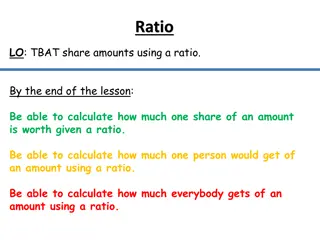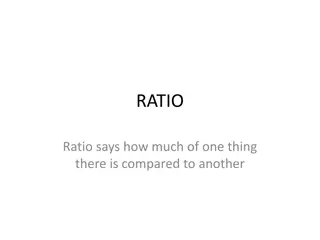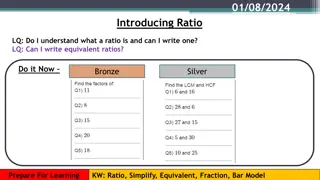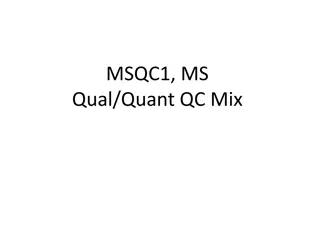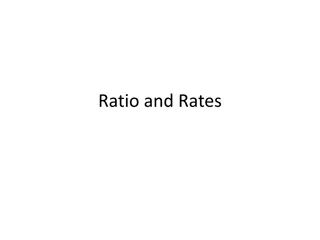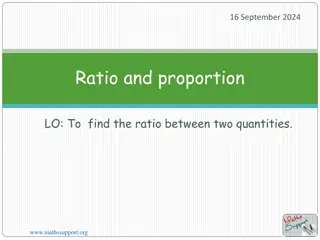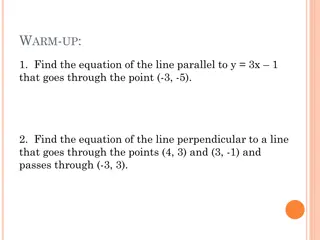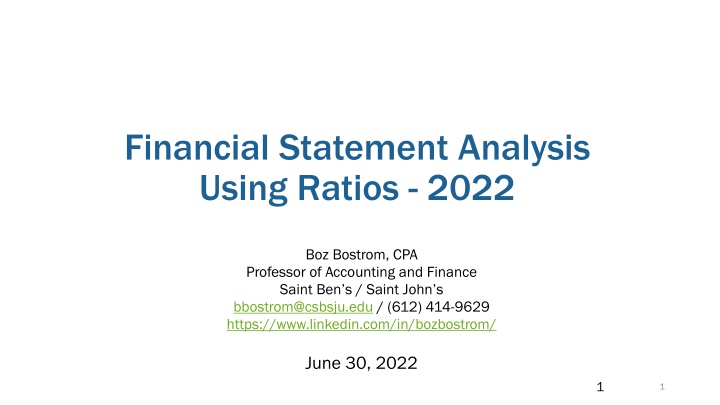
Financial Statement Analysis Using Ratios - Key Learning Objectives and Ratios to Consider
Explore key learning objectives and popular financial ratios for analyzing financial statements. Discover insights on evaluating performance over time and against industry peers. Gain knowledge from leading textbook references and professionals in the field.
Download Presentation

Please find below an Image/Link to download the presentation.
The content on the website is provided AS IS for your information and personal use only. It may not be sold, licensed, or shared on other websites without obtaining consent from the author. If you encounter any issues during the download, it is possible that the publisher has removed the file from their server.
You are allowed to download the files provided on this website for personal or commercial use, subject to the condition that they are used lawfully. All files are the property of their respective owners.
The content on the website is provided AS IS for your information and personal use only. It may not be sold, licensed, or shared on other websites without obtaining consent from the author.
E N D
Presentation Transcript
Financial Statement Analysis Using Ratios - 2022 Boz Bostrom, CPA Professor of Accounting and Finance Saint Ben s / Saint John s bbostrom@csbsju.edu / (612) 414-9629 https://www.linkedin.com/in/bozbostrom/ June 30, 2022 1 1
Logistics Polling questions throughout the meeting Required for CPE If you have issues answering the polling questions, please chat or email across your answer 2.0 CPE Hours (Finance - Technical) Partial credit available minimum of 1.0 hour Questions are very welcome, submit through chat at any time Course evaluation and CPE certificate will be emailed shortly after the session 2
Learning objectives / Agenda Understand key ratios to use in evaluating financial statements Understand how to assess a company s performance over time Understand how to assess a company s performance against its peers 3
What ratios should we use? From a leading Financial Accounting textbook 4
What ratios should we use? From a leading Financial Accounting textbook 5
What is your favorite financial ratio and why? Can I pick one balance sheet ratio and one income statement ratio? I like debt to equity because I think it s generally interesting to know how companies are funded/how leveraged they are. I think net profit margin is just generally interesting as well and how it widely varies among industries, etc Rough question. Two. Debt to equity for long term solvency. Quick ratio for cash flow. ROI. I make a lot of personal decisions based on ROI. Probably the current ratio as it is the only one I know off the top of my head. 6
What is your favorite financial ratio and why? Times interest earned. We think debt is bad but it shows how leverage is powerful. Most useful is PE, buy low and sell high. This is kind of cheating as it isn t one ratio, but I think the DuPont model is the most interesting as it combines analysis of asset efficiency and income management. Does effective tax rate count? I m in tax so gotta go with that. Wow, what a random question. But I love these types of questions. After 60 seconds of deep thought, I m going to go with return on assets. Mainly because although I don t think it s the best way to measure a company s success as an investment, it gives a unique look at efficiency. What is your favorite and why? 7
What is your favorite financial ratio and why? Crikey now there is a question. It s not an easy question...as I always use a combination...as of course they highlight different things! Are we really having this conversation? I m going to say Free Cash Flow Conversion. My rationale is that all my recent CFO positions have been in highly leveraged PE owned businesses where cash has been scarce and critically important. In short, Free cash is king . Hmmmm. Debt to equity because I m a risk averse investor and want to make sure the company I m investing in isn t going to go under in the long term. Current ratio. Cash (and liquidity) are king. 8
Users of Financial Statements Equity Investors Determine whether to buy/sell/hold stock Highly used Earnings per share (in various forms) Price/Earnings Ratio Growth and profitability ratios Less Common Turnover, liquidity, and solvency ratios 9
Users of Financial Statements Lenders Determine whether to extend loans or purchase bonds Determine interest rates Highly used Liquidity and solvency ratios Debt/equity Less Common Market ratios 10
Users of Financial Statements Managers Benchmarking and areas for improvement Forecasting Highly used Profitability, growth Asset utilization (Treasury) Less Common Liquidity, solvency, and market ratios Except to assess how these will be viewed by investors and lenders 11
Users of Financial Statements Auditors Evaluating areas of risk Highly used Asset utilization Increases in days receivables or inventories may require increased reserves Increases in days payables may indicate financial troubles Growth and profitability ratios uses in ASC 350 (Goodwill and Intangible) Valuations Less Common Market ratios 12
Users of Financial Statements Tax Advisors Developing planning ideas and structures / projections often needed Tax valuations and transfer pricing Highly used Market and profitability ratios (for valuations) Solvency (maximizing leverage) Liquidity (transfer pricing) Less Common Turnover 13
How is this company performing (FYE 20 compared to FYE19)? Revenues down 2% Pre-tax income down 64% Gross margins fell from 39% to 38% OI fell from 7% to under 4% Impacted by Gains and restructuring Macy s 14
A companys gross margins decreased from 80% to 68%. How do you expect net income to be impacted? It actually grew by 1123%. How? Net Revenues up 169% Operating margins up from 1% to 7% Op exp down from 79% to 61% Sales/marketing less than doubled when sales almost tripled Zoom (quarterly results). Stock price up 87% from 4/30/19 to 4/30/20 Markets down 1% 15
A company grew revenues by 25% and saw its gross margins decrease from 50% to 49%. How would you expect Operating Income to change? Operating loss nearly tripled. How? SG&A went from 77% of revenue to 110% R&D more than tripled Uber 16
What information are companies focusing on in their earnings releases? 2021 4th quarter releases from five of Minnesota s largest public companies 17
i 18
s 20
Items listed Revenue growth EPS Comparable (organic) sales growth OI as a % of sales Dividend increase Operating cash flow growth Debt reduction Free cash flow conversion 23
Key Ratios in Analyzing Financial Statements (Boz s Opinion) Growth Percent change in revenue Percent change in EPS (GAAP and adjusted) Profitability Gross margin as a % of Net Revenues Operating Income a % of Net Revenues (GAAP and adjusted) Asset Utilization Days Receivables Days Inventories Liquidity Current Ratio Leverage Ratio 25
Less Critical Ratios in Analyzing Financial Statements (Boz s Opinion) ROA, ROE, ROIC, Debt-Equity Can vary wildly based on book vs. market value of assets, which often depends on whether a company grew organically or through acquisitions Okay to use when comparing a company s performance over time, but tough to compare to peers More valid if market equity is used. Problem? Market value is constantly changing 26
Less Critical Ratios in Analyzing Financial Statements (Boz s Opinion) Some prefer EBITDA as a % of Net Revenues, instead of OI as a % of Net Revenues, OI better factors in capital expenditures (through depreciation) Ratios involving Free Cash Flows (Cash flows from Operating Activities less Capital Expenditures) arguably most effective Cash is more subject to manipulation than income P/E is very important, but isn t used in evaluating financial statements 27
Using Ratios Don t look at them in a vacuum Compare them to two things: Company s performance over time Peers performance over time 28
When comparing to company performance over time Some ratios will naturally change over time Can t grow at a higher rate forever Tough to be profitable if investing heavily in R&D and marketing Exclude one-time items (COVID-19) Be careful that these one-time items don t simply recur every year Recurring non-recurring items Improving in one area could cause issues in another area e.g., Driving sales growth by expanding inventory selection, relaxing payment terms or credit standards 29
When comparing to peers Important to identify peers and aspirants Try to identify at least several peers Can look at full range, but also focus on medians and averages Be aware of limitations in your company s strategy which will make it impossible to measure up to peers at times Target will not have same turnover ratios as Costco or Wal-Mart Some banks will take more aggressive approaches or value customer service (higher margins) over maximizing number of loans processed 30
Companies to examine Minnesota-headquartered companies 3M Diversified manufacturer. Sells to retailers Ecolab Water treatment and cleaning products. Sells to businesses Hormel Branded food company. Sells to grocery stores Target Retailer. Sells to consumers United Health Managed healthcare and insurance. Sells to businesses and individuals Xcel Energy Utility company. Sells to businesses and individuals 31
Companies to examine Notable companies Amazon Online sales, cloud computing, digital streaming, and AI. Sells to individuals and businesses Apple Electronics, software, and online services. Sells to individuals and businesses AT&T World s largest telecom company. Sells to individuals and businesses Boeing Aircraft and aerospace manufacturers. Sells to airlines and the government 32
Any predictions? % Change in % Change in Revenues Revenues % Change in % Change in EPS EPS Gross margin Gross margin ratio ratio Days Days Days Days Company Company OI % of Sales OI % of Sales receivables receivables inventories inventories Current ratio Current ratio Leverage Ratio Leverage Ratio 3M 3M 33.3% 33.3% 71.3% 71.3% 41.8% 41.8% 29.8% 29.8% 21.2 21.2 9.1 9.1 1.1 1.1 1.0 1.0 Amazon Amazon 21.7% 21.7% 54.6% 54.6% 29.5% 29.5% 6.4% 6.4% 27.1 27.1 37.8 37.8 1.1 1.1 0.8 0.8 Apple Apple 18.5% 18.5% - -0.5% 0.5% 16.9% 16.9% 9.9% 9.9% 25.6 25.6 47.1 47.1 2.1 2.1 2.5 2.5 AT&T AT&T 16.5% 16.5% 6.0% 6.0% 56.4% 56.4% 16.4% 16.4% 26.3 26.3 36.4 36.4 0.8 0.8 5.4 5.4 Boeing Boeing 13.3% 13.3% 63.1% 63.1% 29.3% 29.3% 8.4% 8.4% N/A N/A 59.8 59.8 1.0 1.0 1.2 1.2 Ecolab Ecolab 11.8% 11.8% 12.9% 12.9% 24.2% 24.2% 8.3% 8.3% 17.2 17.2 N/A N/A 0.8 0.8 1.7 1.7 Hormel Hormel 9.9% 9.9% 8.4% 8.4% 46.8% 46.8% 20.8% 20.8% 48.3 48.3 89.6 89.6 1.7 1.7 1.9 1.9 Target Target 8.0% 8.0% 17.1% 17.1% 40.2% 40.2% 12.6% 12.6% 68.1 68.1 66.5 66.5 1.3 1.3 3.6 3.6 UnitedHealth UnitedHealth 7.1% 7.1% - -65.8% 65.8% 4.8% 4.8% - -4.7% 4.7% 13.5 13.5 494.3 494.3 1.3 1.3 (76.7) (76.7) 3.8 3.8 33 Xcel Energy Xcel Energy - -1.7% 1.7% - -469.3% 469.3% 39.2% 39.2% 13.8% 13.8% 40.8 40.8 12.7 12.7 0.7 0.7
% Change in Revenue Current Year Net Revenues Prior Year Net Revenues Prior Year Net Revenues Higher is Better % Change in % Change in Revenues Revenues % Change in % Change in Revenues Revenues Company Company Company Company Apple Apple 33.3% 33.3% 3M 3M 33.3% 33.3% Amazon Amazon 21.7% 21.7% Amazon Amazon 21.7% 21.7% Median was 12.6% Hormel Hormel 18.5% 18.5% Apple Apple 18.5% 18.5% Xcel Energy Xcel Energy 16.5% 16.5% AT&T AT&T 16.5% 16.5% Target Target 13.3% 13.3% Boeing Boeing 13.3% 13.3% UnitedHealth UnitedHealth 11.8% 11.8% Ecolab Ecolab 11.8% 11.8% 3M 3M 9.9% 9.9% Hormel Hormel 9.9% 9.9% Target Target 8.0% 8.0% Ecolab Ecolab 8.0% 8.0% UnitedHealth UnitedHealth 7.1% 7.1% Boeing Boeing 7.1% 7.1% 34 Xcel Energy Xcel Energy - -1.7% 1.7% AT&T AT&T - -1.7% 1.7%
% Change in EPS Current Year EPS Prior Year EPS Prior Year EPS Higher is Better % Change in % Change in EPS EPS 71.3% 71.3% 63.1% 63.1% 54.6% 54.6% 17.1% 17.1% 12.9% 12.9% 8.4% 8.4% 6.0% 6.0% - -0.5% 0.5% - -65.8% 65.8% - -469.3% 469.3% % Change in % Change in EPS EPS 71.3% 71.3% 63.1% 63.1% 54.6% 54.6% 17.1% 17.1% 12.9% 12.9% 8.4% 8.4% 6.0% 6.0% - -0.5% 0.5% - -65.8% 65.8% - -469.3% 469.3% Company Company 3M 3M Amazon Amazon Apple Apple AT&T AT&T Boeing Boeing Ecolab Ecolab Hormel Hormel Target Target UnitedHealth UnitedHealth Xcel Energy Xcel Energy Company Company Apple Apple Target Target Amazon Amazon Ecolab Ecolab UnitedHealth UnitedHealth 3M 3M Xcel Energy Xcel Energy Hormel Hormel Boeing Boeing AT&T AT&T Median was 10.7% 35
Gross Margin as a % of Net Revenues Gross Margin Net Revenues Higher is Better Gross margin Gross margin ratio ratio 56.4% 56.4% 46.8% 46.8% 41.8% 41.8% 40.2% 40.2% 39.2% 39.2% 29.5% 29.5% 29.3% 29.3% 24.2% 24.2% 16.9% 16.9% 4.8% 4.8% Gross margin Gross margin ratio ratio 56.4% 56.4% 46.8% 46.8% 41.8% 41.8% 40.2% 40.2% 39.2% 39.2% 29.5% 29.5% 29.3% 29.3% 24.2% 24.2% 16.9% 16.9% 4.8% 4.8% Company Company 3M 3M Amazon Amazon Apple Apple AT&T AT&T Boeing Boeing Ecolab Ecolab Hormel Hormel Target Target UnitedHealth UnitedHealth Xcel Energy Xcel Energy Company Company Xcel Energy Xcel Energy 3M 3M Apple Apple Ecolab Ecolab AT&T AT&T Amazon Amazon Target Target UnitedHealth UnitedHealth Hormel Hormel Boeing Boeing Median was 34.3% 36
Operating Income as a % of Net Revenues Operating Income Net Revenues Higher is Better Median was 11.2% Company Company 3M 3M Amazon Amazon Apple Apple AT&T AT&T Boeing Boeing Ecolab Ecolab Hormel Hormel Target Target UnitedHealth UnitedHealth Xcel Energy Xcel Energy OI % of Sales OI % of Sales 29.8% 29.8% 20.8% 20.8% 16.4% 16.4% 13.8% 13.8% 12.6% 12.6% 9.9% 9.9% 8.4% 8.4% 8.3% 8.3% 6.4% 6.4% - -4.7% 4.7% Company Company Apple Apple 3M 3M Xcel Energy Xcel Energy AT&T AT&T Ecolab Ecolab Hormel Hormel Target Target UnitedHealth UnitedHealth Amazon Amazon Boeing Boeing OI % of Sales OI % of Sales 29.8% 29.8% 20.8% 20.8% 16.4% 16.4% 13.8% 13.8% 12.6% 12.6% 9.9% 9.9% 8.4% 8.4% 8.3% 8.3% 6.4% 6.4% - -4.7% 4.7% 37
365 / Net Revenues Avg Accts Rec Days Receivables Higher is Worse Median was 26.3 days Days Days Company Company Target Target Ecolab Ecolab 3M 3M AT&T AT&T Amazon Amazon Xcel Energy Xcel Energy Hormel Hormel Apple Apple UnitedHealth UnitedHealth Boeing Boeing Days receivables Days receivables N/A N/A Company Company 3M 3M Amazon Amazon Apple Apple AT&T AT&T Boeing Boeing Ecolab Ecolab Hormel Hormel Target Target UnitedHealth UnitedHealth Xcel Energy Xcel Energy receivables receivables N/A N/A 68.1 68.1 48.3 48.3 40.8 40.8 27.1 27.1 26.3 26.3 25.6 25.6 21.2 21.2 17.2 17.2 13.5 13.5 68.1 68.1 48.3 48.3 40.8 40.8 27.1 27.1 26.3 26.3 25.6 25.6 21.2 21.2 17.2 17.2 13.5 13.5 38
365 / Cost of Goods Sold Avg Inventories Days Inventories Higher is Worse Median was 53.4 days Days Days Days Days Company Company UnitedHealth UnitedHealth Boeing Boeing 3M 3M Ecolab Ecolab Target Target Hormel Hormel Amazon Amazon Xcel Energy Xcel Energy AT&T AT&T Apple Apple inventories inventories N/A N/A Company Company 3M 3M Amazon Amazon Apple Apple AT&T AT&T Boeing Boeing Ecolab Ecolab Hormel Hormel Target Target UnitedHealth UnitedHealth Xcel Energy Xcel Energy inventories inventories N/A N/A 494.3 494.3 89.6 89.6 66.5 66.5 59.8 59.8 47.1 47.1 37.8 37.8 36.4 36.4 12.7 12.7 9.1 9.1 494.3 494.3 89.6 89.6 66.5 66.5 59.8 59.8 47.1 47.1 37.8 37.8 36.4 36.4 12.7 12.7 9.1 9.1 39
Current Assets Current Liabilities Current Ratio Higher is Conservative Median was 1.1 Company Company 3M 3M Amazon Amazon Apple Apple AT&T AT&T Boeing Boeing Ecolab Ecolab Hormel Hormel Target Target UnitedHealth UnitedHealth Xcel Energy Xcel Energy Current ratio Current ratio Company Company Hormel Hormel 3M 3M Boeing Boeing Ecolab Ecolab Amazon Amazon Apple Apple Target Target Xcel Energy Xcel Energy UnitedHealth UnitedHealth AT&T AT&T Current ratio Current ratio 2.1 2.1 1.7 1.7 1.3 1.3 1.3 1.3 1.1 1.1 1.1 1.1 1.0 1.0 0.8 0.8 0.8 0.8 0.7 0.7 2.1 2.1 1.7 1.7 1.3 1.3 1.3 1.3 1.1 1.1 1.1 1.1 1.0 1.0 0.8 0.8 0.8 0.8 0.7 0.7 40
Debt EBITDA Leverage Ratio Higher is Aggressive Median was 1.7 Company Company 3M 3M Amazon Amazon Apple Apple AT&T AT&T Boeing Boeing Ecolab Ecolab Hormel Hormel Target Target UnitedHealth UnitedHealth Leverage Ratio Leverage Ratio Company Company Xcel Energy Xcel Energy AT&T AT&T Ecolab Ecolab Hormel Hormel 3M 3M UnitedHealth UnitedHealth Target Target Apple Apple Amazon Amazon Leverage Ratio Leverage Ratio 5.4 5.4 3.8 3.8 3.6 3.6 2.5 2.5 1.9 1.9 1.7 1.7 1.2 1.2 1.0 1.0 0.8 0.8 5.4 5.4 3.8 3.8 3.6 3.6 2.5 2.5 1.9 1.9 1.7 1.7 1.2 1.2 1.0 1.0 0.8 0.8 Xcel Energy Xcel Energy (76.7) (76.7) Boeing Boeing (76.7) (76.7) 41
The final results! % Change in % Change in Revenues Revenues % Change in % Change in EPS EPS Gross margin Gross margin ratio ratio Days Days Days Days Company Company OI % of Sales OI % of Sales receivables receivables inventories inventories Current ratio Current ratio Leverage Ratio Leverage Ratio Apple Apple 33.3% 33.3% 71.3% 71.3% 41.8% 41.8% 29.8% 29.8% 21.2 21.2 9.1 9.1 1.1 1.1 1.0 1.0 Amazon Amazon 21.7% 21.7% 54.6% 54.6% 29.5% 29.5% 6.4% 6.4% 27.1 27.1 37.8 37.8 1.1 1.1 0.8 0.8 Hormel Hormel 18.5% 18.5% - -0.5% 0.5% 16.9% 16.9% 9.9% 9.9% 25.6 25.6 47.1 47.1 2.1 2.1 2.5 2.5 Xcel Energy Xcel Energy 16.5% 16.5% 6.0% 6.0% 56.4% 56.4% 16.4% 16.4% 26.3 26.3 36.4 36.4 0.8 0.8 5.4 5.4 Target Target 13.3% 13.3% 63.1% 63.1% 29.3% 29.3% 8.4% 8.4% N/A N/A 59.8 59.8 1.0 1.0 1.2 1.2 UnitedHealth UnitedHealth 11.8% 11.8% 12.9% 12.9% 24.2% 24.2% 8.3% 8.3% 17.2 17.2 N/A N/A 0.8 0.8 1.7 1.7 3M 3M 9.9% 9.9% 8.4% 8.4% 46.8% 46.8% 20.8% 20.8% 48.3 48.3 89.6 89.6 1.7 1.7 1.9 1.9 Ecolab Ecolab 8.0% 8.0% 17.1% 17.1% 40.2% 40.2% 12.6% 12.6% 68.1 68.1 66.5 66.5 1.3 1.3 3.6 3.6 Boeing Boeing 7.1% 7.1% - -65.8% 65.8% 4.8% 4.8% - -4.7% 4.7% 13.5 13.5 494.3 494.3 1.3 1.3 (76.7) (76.7) AT&T AT&T - -1.7% 1.7% - -469.3% 469.3% 39.2% 39.2% 13.8% 13.8% 40.8 40.8 12.7 12.7 0.7 0.7 3.8 3.8 42
Things not always as they seem Percent change in revenue Higher is normally better, but Costs can get out of control Percent change in EPS (GAAP and adjusted) Higher is normally better, but Cost-cutting which focused on the short-term Gross margin as a % of Net Revenues Higher is normally better, but Competitors will eventually catch-up Operating Income a % of Net Revenues (GAAP and adjusted) Higher is normally better, but Could turnover be increased? 43
Things not always as they seem Days Receivables Lower is normally better, but Are tight credit policies restricting sales growth? Days Inventories Lower is normally better, but Are stockouts more likely? Current Ratio Higher is normally conservative, but Conservative strategies can lower returns Leverage Ratio Lower is normally conservative, but Could debt be more effectively utilized? 44
Be careful to consider other factors How did days inventory change each year? No averaging Went from 78 to 114! With averaging Went from 75 to 88 Toro. Major acquisition about way through the year. 45
Bozs favorite ratio? Good things come to those who grow sales! 2012 2012 2013 2013 2014 2014 2021 2021 Total net sales Total net sales 61,093 61,093 74,452 74,452 88,988 88,988 469,822 469,822 Cost of sales Cost of sales 45,971 45,971 54,181 54,181 62,752 62,752 272,344 272,344 Fulfillment Fulfillment 6,419 6,419 8,585 8,585 10,766 10,766 75,111 75,111 Marketing Marketing 2,408 2,408 3,133 3,133 4,332 4,332 32,551 32,551 Technology Technology G&A G&A 4,564 4,564 896 896 6,565 6,565 1,129 1,129 9,275 9,275 1,552 1,552 56,052 56,052 8,823 8,823 Other Expenses Other Expenses 159 159 114 114 133 133 62 62 Income from operations Income from operations 676 676 745 745 178 178 24,879 24,879 Net income (loss) Net income (loss) (39) (39) 274 274 (241) (241) 33,364 33,364 Total net sales Total net sales Cost of sales Cost of sales Fulfillment Fulfillment Marketing Marketing Technology Technology G&A G&A Other Expenses Other Expenses Income from operations Income from operations Net income (loss) Net income (loss) 100.0% 100.0% 75.2% 75.2% 10.5% 10.5% 3.9% 3.9% 7.5% 7.5% 1.5% 1.5% 0.3% 0.3% 1.1% 1.1% - -0.1% 0.1% 100.0% 100.0% 72.8% 72.8% 11.5% 11.5% 4.2% 4.2% 8.8% 8.8% 1.5% 1.5% 0.2% 0.2% 1.0% 1.0% 0.4% 0.4% 100.0% 100.0% 70.5% 70.5% 12.1% 12.1% 4.9% 4.9% 10.4% 10.4% 1.7% 1.7% 0.1% 0.1% 0.2% 0.2% - -0.3% 0.3% 100.0% 100.0% 58.0% 58.0% 16.0% 16.0% 6.9% 6.9% 11.9% 11.9% 1.9% 1.9% 0.0% 0.0% 5.3% 5.3% 7.1% 7.1% 46
Final Reminders Pick ratios that make sense based on the company s industry Look for improvement over time, subject to limitations as the company matures Carefully select peers/aspirants and use benchmarking as one factor in assessing performance Adjust for unusual items 47



